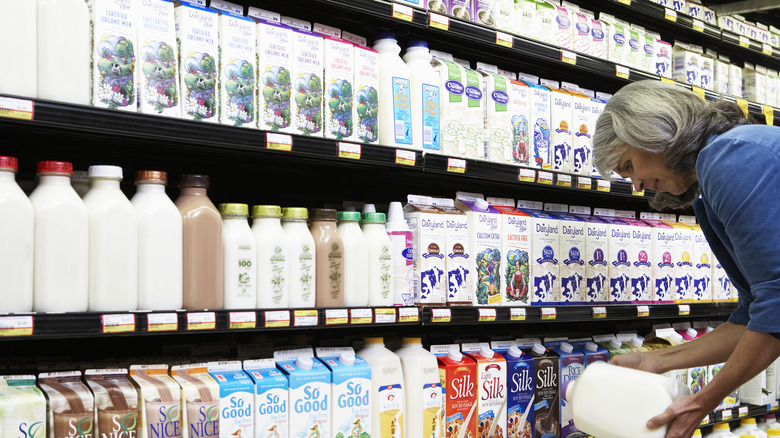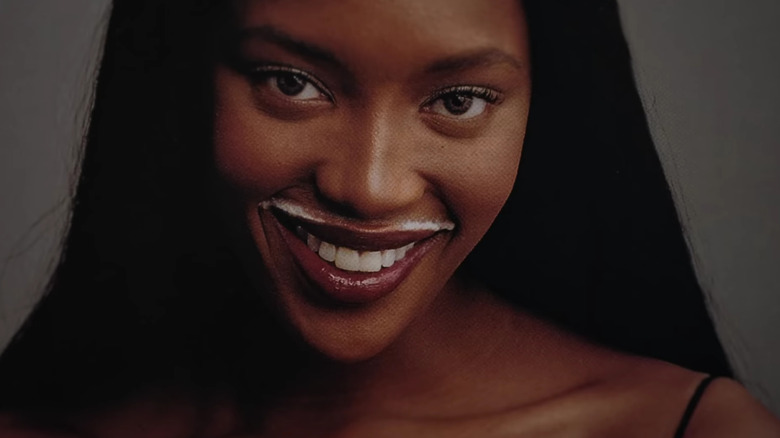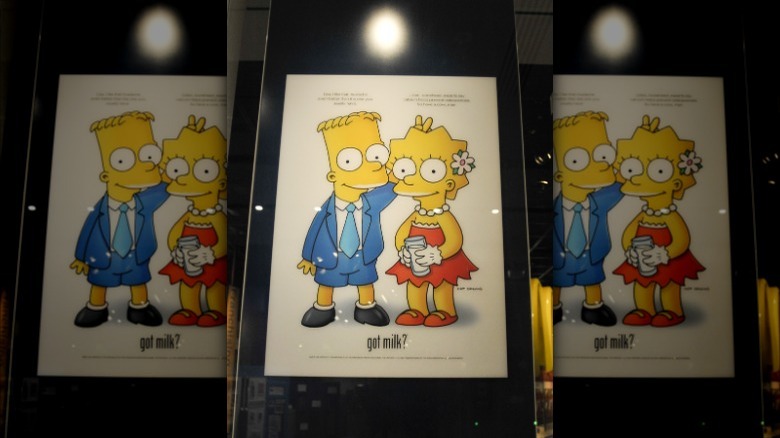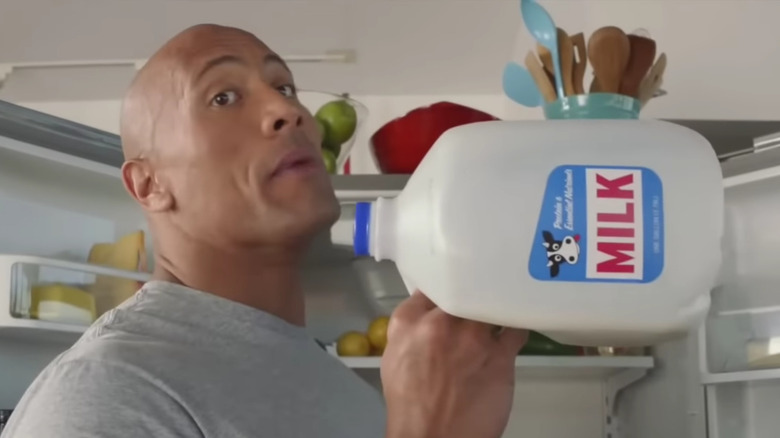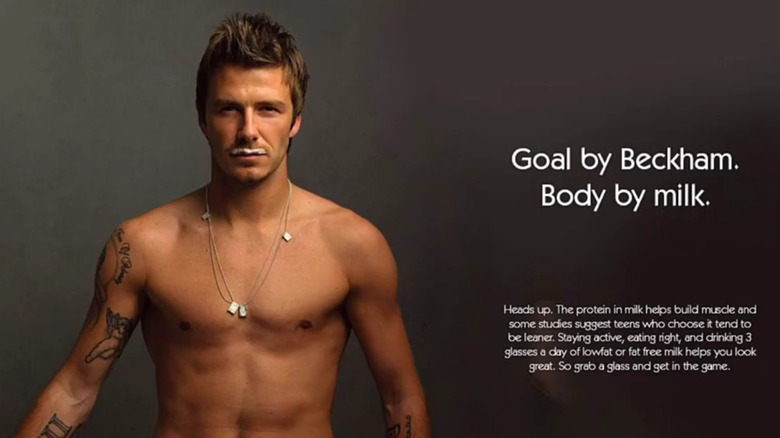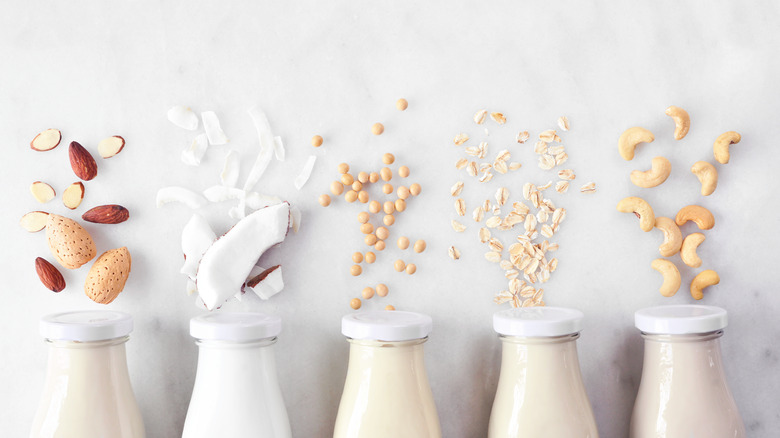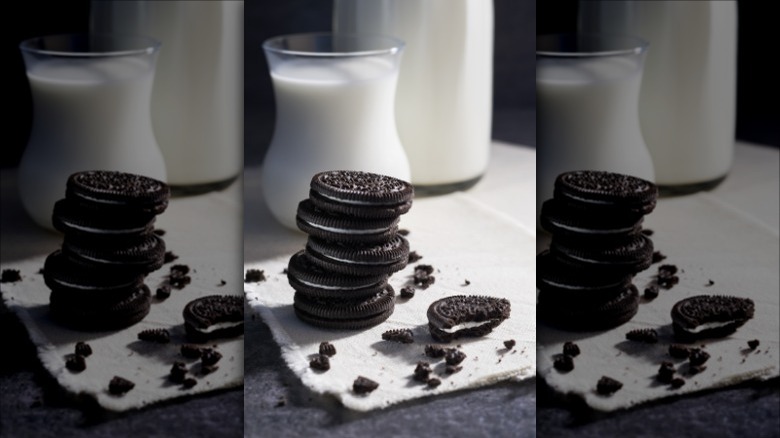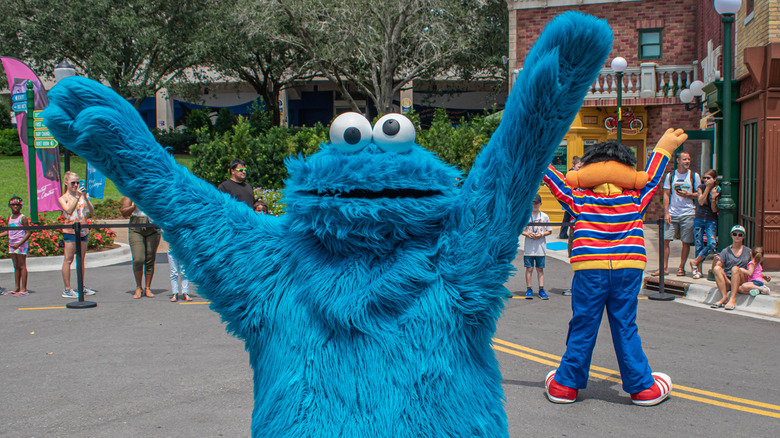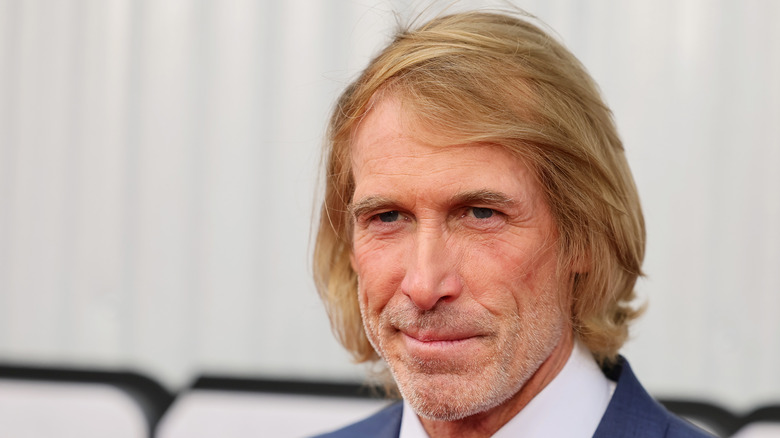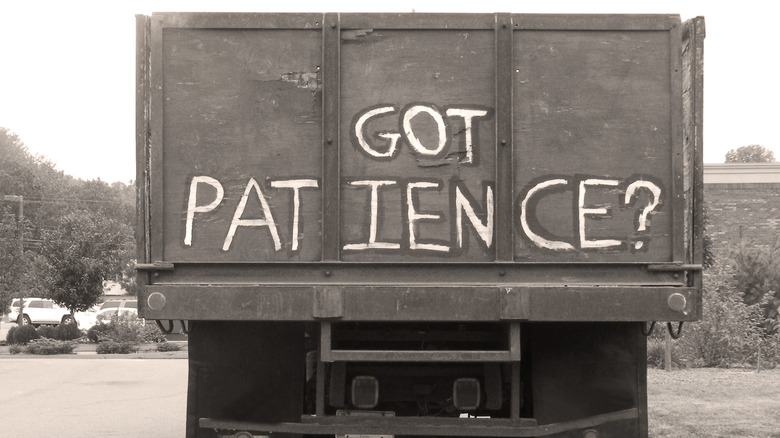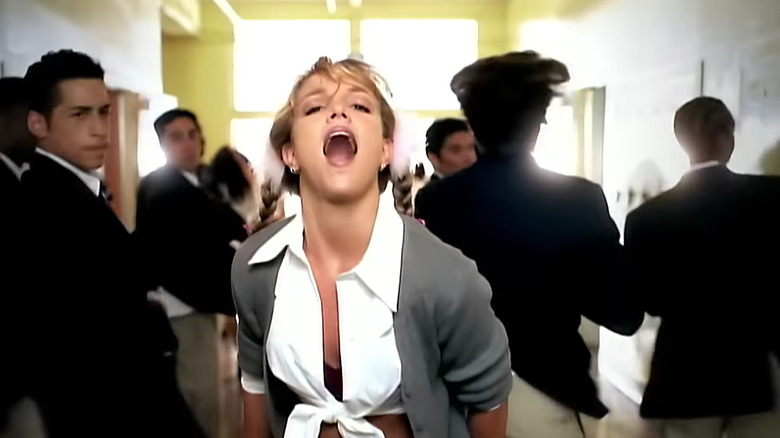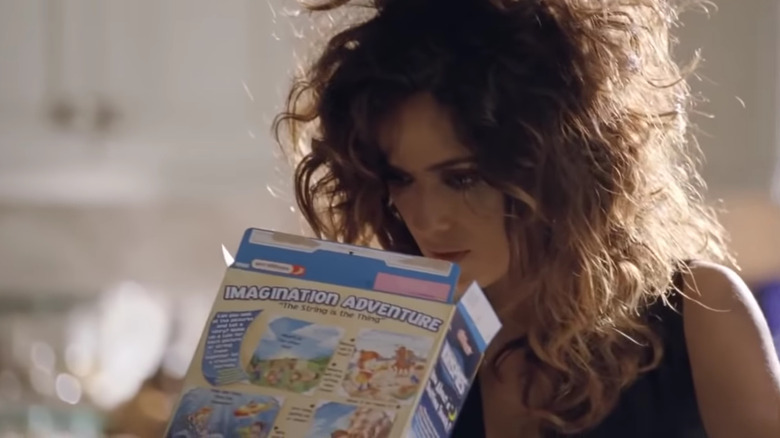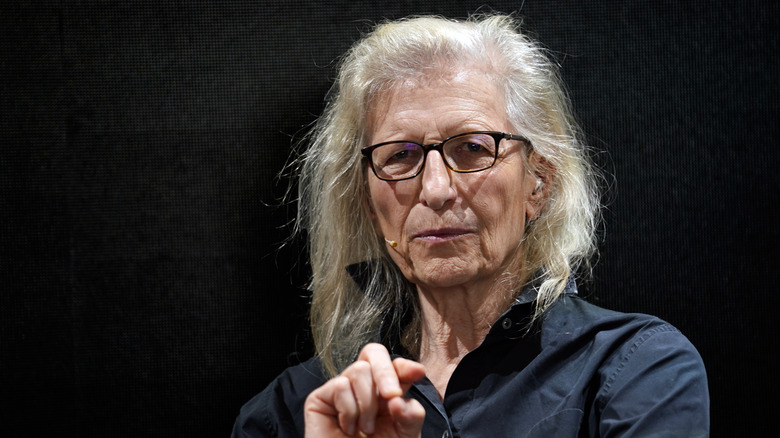Whatever Happened To The Celebrity Milk Mustache Ads?
Let's play a word-association game. What comes to mind when you hear the following words: standout, exceptional, or difficult-to-acquire? Perhaps you thought of something like a new iPhone. We're gonna go out on a limb and guess that milk wasn't your answer. If that's the case, then you understand what the powers that be in the milk industry faced in the 1990s. They needed to figure out how to stop the free fall in milk sales that had been ongoing for decades. How could they do that with a product that, for the most part, people didn't think about at all unless they ran out of it? Milk is, at best, an afterthought for most people.
As it turns out, it was this quality that led to a series of ads with milk-mustached celebs who were part of the 2.0 version of the famous "Got Milk" ad campaign. At its peak, celebrities everywhere practically begged, borrowed, or stole their way into these ads, and the roster of celebs who bore the famous white 'stache ranged from movie and TV stars, like The Rock, to Olympic athletes, like Apolo Ohno. You pretty much couldn't go anywhere for 20 years or so without seeing the white-lipped portrait of the day's "it" guy or girl. But if the milk-mustached celebs were so memorable, why don't we see those ads anymore? If you've ever wondered, then pour yourself a glass of milk and read on.
The milk mustaches appeared in 1995
It might surprise most people to learn that the "Got Milk" print ads that paired the uber-famous with their very own milk mustaches only began in 1995, two years after the original "Got Milk" campaign got underway. Supermodel Naomi Campbell bore the famous 'stache first. With the unveiling, the once-quirky peanut butter-in-the-mouth ads took on paparazzi-worthy celebrity style.
The merger was a result of the Milk Processor Education Program (MilkPEP) joining forces with the California Milk Processor Board, the group that spearheaded the "Got Milk" slogan, as well as the original commercials that came with it. Although the celeb-encrusted milk ads scrolled across billboards and glossy magazines with the regularity of the full-moon cycle, they weren't exactly stellar moneymakers for the stars who appeared in them. Celebs earned $25,000 for the ads — a far cry from what they might earn elsewhere — which just goes to show the power of a milk-topped smile at the time.
The tagline Got Milk preceded the milk mustaches
Unlike the age-old question of "Which came first, the chicken or the egg," we know which came first in the "Got Milk?" campaign — it was the "Got Milk" slogan. In 1993, the California Milk Processor Board merged heads — creatively speaking — with the advertising company Goodby, Silverstein & Partners, to create what would eventually become one of the most famous ad campaigns in history.
The ad's purpose was simple. Turn an ordinary, kinda bland product into something that people not only raved about but practically tripped over one another in the grocery stores to buy. This was easier said than done. It isn't an exaggeration to say that even the ad execs couldn't see how they would make the "most boring project imaginable" (per Time) into the sizzle that sells the steak. Some trial and error and a few realizations, (namely, that people didn't think about milk until they were out of it) ultimately sparked the phrase "Got Milk?"
That innocent two-word question inspired a 20-year odyssey that spawned hundreds of ads. Since the campaign started in California, it's unsurprising that 70 of the ads appeared in Cali alone. About 350 of them featured the famous mustache, exploding on TV and in print ads locally and nationally. Aside from winning numerous awards, the campaign won countless eyeballs. Four-fifths of Americans saw the ads during all the years they ran (via Fast Company).
Got Milk embraced deprivation marketing
Here's a true story. The "Got Milk" campaign roped a bunch of volunteers into agreeing not to keep milk in the house for a week. Basically, the ad execs at Goodby, Silverstein & Partners wanted to do some brain-picking with respect to people's milk-drinking habits. One pre-campaign research participant even went as far as to toss some cereal and bananas in their bowl before remembering they didn't have any milk on hand. From this, ad execs learned that people kind of expect to find milk in the fridge, whether they've bought it or not. It's supposed to miraculously reappear on the shelf once the last drop is dumped on cereal, sort of like the never-ending soup cauldron in the Grimms' fairy tales. The more you ladle out of the bowl, the more you find there.
That's not how it works, of course, but this idea of being suddenly deprived of milk at a crucial moment led to the inspiration for the "Got Milk" slogan. Pre-milk-mustache ads played around with this notion. This approach created a visceral response among the public, because who hasn't poured a bowl of dry cereal only to remember the absence of milk in the fridge? Unlike earlier ads, the campaign didn't center on the nutritional value of milk, but rather on the FOMO factor, and it worked brilliantly.
A-List celebs added a power punch to the ads
Britney Spears. David Beckham. Sarah Michelle Gellar. All superstars, and more importantly for the purposes of the ads, all milk drinkers. It didn't matter how A-List someone was. If he or she wasn't a milk drinker, an appearance in the "Got Milk" milk mustache ads was a no-go. The question is, did any star who wanted to be in a milk ad get left out? That's an affirmative. Until lactose-free milk hit the market, "Got Milk" campaign lover Whoopie Goldberg was skipped over due to being a lactose-intolerant non-milk drinker. Thank goodness for a little patience on her part — and the advent of lactose-free milk — or she's one superstar we would have never seen in a "Got Milk?" commercial.
For the $25,000 — a practical pittance compared to what she and other "Got Milkers" could command for a regular gig — it's tempting to think that the powers-that-be with the California Milk Processor Board and Milk Processor Education Program would give their eye teeth to schedule a roster of A-Listers for their commercials. Nope. In the '90s, having your face on a "Got Milk" ad was the dairy equivalent of the Hollywood Walk of Fame, and even A-Listers had to earn the right to their own star.
Despite its ubiquity, it didn't affect the downturn of milk consumption
From 1975 onward, the sale of milk has fallen, dropping by 25% per capita from 1975 to 2012 (via U.S. Department of Agriculture). Adding insult to injury, the demand for cereal, milk's best friend in the morning, fell too. This created the perfect storm that inspired milk producers to do something drastic. It was out of desperation that the "Got Milk" campaign was born.
Still, despite the campaign's $23 million-dollar-a-year budget and 20-year push, milk sales continued on a downward slope. Jeff Manning, Executive Director of the Milk Processor Board, argued that while it was true that milk sales were falling, it was also true that the "Got Milk" campaign slowed the decline. He predicted milk sales would have fallen by $255 million per year had it not been for the ad campaign, per Mental Floss. Industry experts suggest that increased competition from plant milks, as well as the public's propensity for sugary sodas and protein-infused breakfasts that don't call for milk, all contributed to the fall of moo juice sales.
The campaign adopted piggyback marketing
Milk is a drink of accompaniments, meaning that most people don't just grab a glass like they do a soda or Gatorade. Instead, milk usually goes with something, like cereal, and other foods too, such as cookies. While celebs wearing a white caterpillar on their upper lip became the public face of the "Got Milk" campaign, there was a very clever piggyback marketing campaign taking place in the background. Early on in the campaign, the milk producers allowed brands like Oreos, as well as cereal brands, to license the "Got Milk" slogan free of charge. And it wasn't just grocery store cookies that adopted "Got Milk." Girl Scouts eventually did, too.
The purpose of piggyback marketing, of course, is to build relationships with complementary but not competing industries to share marketing costs. Cereal and cookie companies make sense. However, the campaign took on new qualities when the piggyback marketing efforts moved past logical, complementary markets, like cookies and cereal, and moved into pop culture at large. Case in point? An agreement to license "Got Milk" to Mattel and Barbie.
It was the first endorsement the Children's Television Workshop ever did
It doesn't take a lot of brain-wracking to know that the perfect mascot for a milk ad campaign is none other than the blue creature himself, Cookie Monster. The challenge in getting the Children's Television Workshop (CTW) on board was its brand policy. That is, the non-profit wasn't in the business of promoting brands.
If you're scratching your head, thinking you surely saw Cookie Monster and even Kermit the Frog in "Got Milk" ads, you'd be right. It wasn't so much that the CTW crumbled — no pun intended — but more a matter of semantics. Jeff Manning pointed out to the powers that be at CTW that milk isn't a brand; it's a category of food. That proved enough to get the non-profit to eventually allow the use of muppets to help out with the "Got Milk" campaign.
Transformers Director Michael Bay directed the 1993 Aaron Burr ad
Michael Bay, the director and producer known for his work on "The Transformers," "Pearl Harbor," and "The Teenage Mutant Ninja Turtles," got a big break early on in his career when the California Milk Processors tapped him to direct the first "Got Milk" commercial. It might have been a pretty low-key and boring gig for a director who built his reputation on blowing stuff up in movies, but getting him onboard was genius.
The commercial featured a historian trying to win $10,000 for answering the question: Who killed Alexander Hamilton? Were it not for the pesky bite of peanut butter bread stuck to the roof of his mouth and a lack of milk to wash it down, the historian could have uttered something more coherent than "Awon Buuh" and won the $10 grand. The commercial set the tone for the quirky ads that preceded the milk mustache ads.
Bay had recently graduated from film school at the Art Center College in Pasadena when the offer for the gig came. The idea to feature a guy living in a garage with his car sprung from Bay's brain. It made no sense but was funny and just the kind of thing that makes you ponder. It solidified the "Got Milk" campaign as a pop culture force and created a foundational concept for the ads, which focused on the consequences of being deprived of milk at crucial times.
The ads sparked plenty of parodies and copycats
If imitation and parody equal the highest forms of flattery, then the "Got Milk" campaign has certainly seen its share of admiration over the years. The slogan eventually formed the foundation for slogans like "Got Jesus," "Got Identity," "Got Democracy," "Got Patience," and even "Got Ice?" However, most of these campaigns didn't see the success that "Got Milk" did, partly because while imitation might get you noticed, originality wins the day and people's extended attention.
That said, the reach of the "Got Milk" ad campaign was long and, for a time, provided plenty of people with a springboard for their products and services. One person, in particular, got extra notoriety from the ad campaign: Jeff Manning, the former Executive Director of the California Milk Processor Board. These days, he doesn't push milk, but he is still in the marketing and ad business. You can find him at his website www.GotManning.com, of course.
It capitalized on the explosion of celebrity culture
While people have always had a thing for the new "it" guy or girl in Hollywood, the frenzy around celebrities really began to climb in the early 1980s and 1990s when 24-hour TV hit the airwaves. CNN was the first to introduce 24-hour news programming, and MTV followed one year later. Instead of needing to find enough content to fill one half-hour time slot per day, cable news networks needed to fill nearly 50 of them. Celeb news offered plenty of content.
"Got Milk" 2.0, the milk mustache edition, capitalized on the insatiable hunger that ubiquitous celebrity created among the masses. Although TV reigned supreme back then, people still read glossy magazines and appreciated billboards. For the "Got Milk" campaign, this translated into milk mustache gold. True enough, the milk processors spent millions on ads. However, as far as the "Got Milk" ads went, it didn't hurt that celebs like Britney Spears, Christie Brinkley, and the cast of "Friends" already held a spot in the public's consciousness. The heavy lifting was done by those celebs' other vehicles, highlighting the fact that celebrity culture and its followers did a lot to bring the ads forward.
The ads celebrated quirky weirdness
The approach to "Got Milk" 1.0 versus "Got Milk" 2.0 changed drastically. Whereas version 2.0 celebrated the glitz of celebrity, version 1.0 embraced quirky humor. While the Aaron Burr commercial may be the most well-remembered of the original "Got Milk" ads, the roster of commercials shot by the California Milk Processor Board when the slogan was solely its own (and not a shared entity with MilkPE) wore the mantle of weirdness boldly. Some of the more memorable commercials included a man who, after entering what looks like paradise, begins munching on piles of cookies only to discover there's no milk to wash them down with. It's only at the end of the commercial that we realize that being deprived of milk is Paradise Lost instead of Paradise Found.
Later commercials merged celebrity culture with quirk and included cameos by celebs like Salma Hayek. In her story, she walks to the end of the earth to find milk, including visiting cows out in the field ... only to discover that she's also out of cereal. At the outset of these early campaigns, audiences didn't even know they were watching a milk commercial. They just knew they were witnessing deprivation made funny through a form of dark humor that had never been seen in the same ad space as a wholesome everyday product like milk. And, of course, they drank it up.
Famed photographer Annie Leibovitz was the photo bug
In her book "Annie Leibovitz at Work," photographer Annie Leibovitz shares a very important lesson she learned while photographing the Rolling Stones. A person's association with famous people can give them as much power and fame as actually being famous themselves. That lesson from her work in the 1970s certainly helped her navigate her career in the years that followed. She eventually became a photographer for Rolling Stone magazine, known for her portraits of celebrities. Her use of lighting and ability to bring out the intimate qualities of each person made her a darling of the fashion and celebrity press.
It's no accident that the "Got Milk" photos have the look of high-fashion photography. One-hundred-eighty of the photos came from Annie Leibovitz's camera, and at one time, she fought to be the sole photographer on the project. It made sense from a career perspective. At that time, magazine advertising hit its peak, and having multiple photos spread across multiple glossy magazines meant that the photographer would once again enjoy fame by association, just as she did when she rode along with the Rolling Stones. She was one smart cookie. The milk processors made the photos ubiquitous in magazines and on billboards. She went along for the ride and, in the process, helped create one of the most recognizable photo campaigns in history.
The Milk Life campaign replaced it in 2014
As far as advertising cycles go, milk seems to have come full circle. Before the "Got Milk" campaign kicked off, there was the "Milk: It does a body good" campaign, which emphasized milk's role in attaining good health. The "Got Milk" campaign warned people of impending cereal and cookie tragedies if they ran out of milk. And then, it brought forth the high-glamor milk mustache shots.
In February 2014, The Milk Processor Education Program began embracing health and fitness again in its new "Milk Life" campaign. Instead of emphasizing peanut-butter-mouthed historians or white-caterpillar-lipped celebs, this campaign embraced everyday athletes downing milk to stay healthy. Milk processors hoped that people would reach for a glass of milk as their source of protein in the morning, instead of a protein bar or even almond milk. The other notable changes included who starred in the commercials. Whereas "Got Milk" was once the domain of A-List celebrities, the "Milk Life" campaign featured average Joes and Josephines living their best lives.
"Got Milk" isn't gone completely. The phrase is still license-worthy, which means milk processors can still make money off it by licensing the slogan to other entities, like cookie companies. It also still has a spot in milk ads in California. The most accurate thing we can say about "Got Milk" is that it's sitting in limbo — not completely forgotten, but not the A-list star anymore, either.
